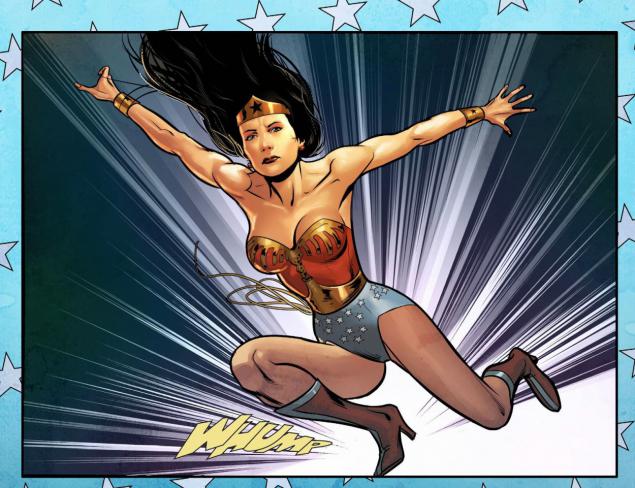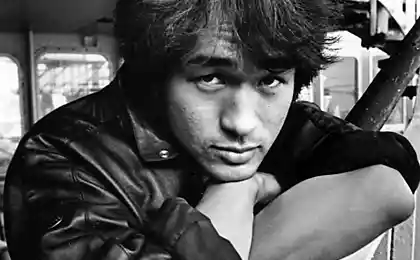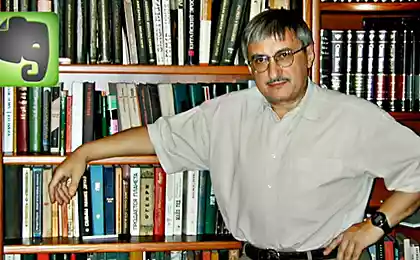1039
How to draw a comic book: an interview with the artist
The main thing - is not popular today otvlekatsyaMnogie film begins with imperceptible printed pages - not with the novels and comics. To capture the most important moments of the narrative, without disrupting its coherence requires a skilled illustrator. And what it is - every day again be facing a blank page?

to become better acquainted with the work of the ordinary illustrator we talked with Matt Haley, professional risuyuschim comics DC, Marvel and many other companies for more than twenty years. Matt told us about how he packed up his life in a pickup to get a chance to get into comics.
Tell us a little about yourself and your experience
I, Matt Haley, has been a professional illustrator of comic books since 1991. Now I draw comics "Wonder Woman '77" for the company DC Comics Digital. Fans of comics probably know my work for DC «Superman Returns," "Best in Elsvorde: Supergirl and Betgerl", and many others, as well as the "Phantom" for Dark Horse Comics, and "Order" for Marvel. Over the past few years, I was also responsible for the artistic component of numerous media projects master Stan Lee comic books, such as "Who wants to be a superhero," and "Comic-Con Episode Four: Fan hope" Morgan Spurlock. I'm also the director of the popular online video "Black Star Warrior».
What made you choose your career?
I never had any doubts - I grew up on comic books about Batman, Neal Adams and Shade, the Changing Man Steve Ditko, and already in the age of four, told his parents that "going to be a comic book artist." I myself can say, taught himself to this work: locked in her room and painted all day, every day, often at the expense of homework.

How did you find a job? What kind of education and experience required to you?
In 1990, I went to college in New Mexico, and read edition of the magazine "Comic Buyer's Guide," which tells about the festival Comic-Con was held that summer in San Diego. Among other things, it said that the festival Editors different companies will study the portfolio emerging artists of comics. Learning of this, we roommate Tom Simmons decided to try his luck and draw a few samples.

I reasoned that the film Batman of 1989 still flashed absolutely everywhere, which means everyone will just draw it. So I have to choose some more original theme. And I chose "Star Trek: The Next Generation." I was a terrible konturovschikom, and this work took on Tommy and masterfully executed it, and I did the actual drawings.
We drew a lot of samples, piled their belongings into a pickup and drop everything, went to San Diego. We had no place to stay, and we had nowhere to return. We went to nowhere! At the festival, we have received good reviews and made a second set of samples of which have been painted my first big job "Star Trek: The Next Generation. Yearbook number 2 "for the company DC. Page 54 - I was thrilled and terrified at the same time.

You needed any licenses or certificates?
Just a good portfolio. This is the only thing that interests the bosses, if you really know how well and tirelessly to draw. A good editor can define the professional work even if the art style is unusual, and the tireless and permanence - a key factor in any job.
How do you tune in to the job? At that spend most of the time?
The main thing - do not be distracted. Drawing (and lately for me and writing) it is extremely time-consuming work, and I need to be fenced off from the world, to focus on. Recently, I turned off the computer from the Internet, and my productivity has doubled. Most of the time I spend drawing, listening to very loud music on headphones. Sometimes, in correspondence with the editor, and some customers by e-mail, but mostly just paint until it is time for yoga.
What misconceptions about your work are most common?

Oh, a lot of things, like, "Wow, you're working at home, it is probably so cool" or "you're working with Stan Lee, you must be famous." I have always been an independent artist, so I really have no idea what "office work».
People think that comics artists are rich; Unfortunately, it is quite far from the truth. Money barely enough from paycheck to paycheck, but no matter what I would not trade my job. Artists are very lucky - they have freedom, they do not want to wake up every morning by the alarm signal. My journey to work is about 5 meters, and I can work in anything, even in your pajamas.
How many hours a day do you usually work?
I used to work every day for as long as literally did not fall down, but as I get older, I try to work less. I am currently working about twelve hours a day, but the drawing does not take all that time. Some of it I spend on writing articles in various projects, such as in cooking. I work six days a week and try to take one day off. Daily yoga helps me to maintain a sound mind and a strong back.

What is your job easier?
The transition to "figure". I started Photoshop and Illustrator in 1999, the year, but I try to keep in the hands of traditional art materials. A business management training helped me learn how to determine the time required to create a single work, so I have never broken deadlines.
What is for you the worst of all, and how do you deal with this?
The lack of a regular salary. Many artists try to have multiple sources of income - selling T-shirts and sketches take their own commissions, etc... But I do not do such things. And yet sometimes hard to fight the urge to snack while you work. I try to eat nuts, dried fruit and tea, but sometimes I can afford and chocolate Ritter Sport.

What is the most enjoyable part of the job?
Painting. Continuous clock work. View interesting film during operation. A look at a completed page and understanding that you hit the nail.
Do you have any advice for people interested in your services?
Yes, they can visit my website and send me a message via the contact form. I have been working for a long time, so usually determines what the customer wants, even during the first consultation. You will be surprised to know how many people would like to use the services of an artist, but consider that it is difficult, or that artists - very creative, and difficult to deal with.
The truth is that we - the ordinary people who know how to draw. I would add that most people do not have the slightest idea of how to create our works and can not understand that the way we earn a living. Often asked to draw something for free, with phrases such as "You like to draw," or "You can do it over the weekend?". So I usually suggest customers ask your lawyer or plumbing work for free.

How much can you earn?
There is no standard. I have a quotation that I set on the basis of their experience and a list of previous customers, but the starting salary is not as such. Artist working on Marvel and DC, can earn $ 100- $ 200 or more for a page and draw a pencil around $ 75-150 for the ink. Small publishers usually pay about half of these amounts.
This is only general numbers. If you can draw one or two pages a day, you can earn 40,000 - $ 50,000 a year (in the US). Many artists have a spouse who can support their efforts, but, probably, it is difficult to support a family on a single art. I have no children, so I'm a little bit easier.
How to move forward in this area?
Oh, that's an important question, is not it? But no one knows the answer. Especially in the field of comics. At the whim of the editor, hires you, the marketing department, marketing your work, society (hopefully) a loving and buy these works. Many modern artists have entered the business at the same time with me, and have benefited from the speculative market comics before he crashed, so get famous.
The most important thing in teaching drawing comics - what a great training ground for nearly all artistic disciplines. A career may depend largely on luck. I think the important thing is not to give up and not to give up.
What value or, conversely, underestimate your customers?
Customers tend to overestimate their own knowledge of art and underestimated artist. Art really is not very much appreciated in our culture, in contrast to, say, a professional sports. All people think that they can do a pretty good draw and write. Explain what is the difference between the pro and amateur work, people without artistic taste is difficult. But it is, unfortunately, a universal problem all illustrators, designers and artists. It is unlikely that it has any solution other than patience on your part.
What advice do you wish to join your profession?
Be aware that you may have to sacrifice a lot to become a good comic book artist. It's not for everyone. I would recommend coming artists start their comics on the Internet and try to get the audience. Many artists think they can come in and immediately start drawing Spider-Man. But this is not so. This is the sphere terrible competition, which does not always win objectively stronger. Send the work of the small publishers to work with them and see if you notice bigger companies. As corny as it may sound - never give up.
via factroom.ru

to become better acquainted with the work of the ordinary illustrator we talked with Matt Haley, professional risuyuschim comics DC, Marvel and many other companies for more than twenty years. Matt told us about how he packed up his life in a pickup to get a chance to get into comics.
Tell us a little about yourself and your experience
I, Matt Haley, has been a professional illustrator of comic books since 1991. Now I draw comics "Wonder Woman '77" for the company DC Comics Digital. Fans of comics probably know my work for DC «Superman Returns," "Best in Elsvorde: Supergirl and Betgerl", and many others, as well as the "Phantom" for Dark Horse Comics, and "Order" for Marvel. Over the past few years, I was also responsible for the artistic component of numerous media projects master Stan Lee comic books, such as "Who wants to be a superhero," and "Comic-Con Episode Four: Fan hope" Morgan Spurlock. I'm also the director of the popular online video "Black Star Warrior».
What made you choose your career?
I never had any doubts - I grew up on comic books about Batman, Neal Adams and Shade, the Changing Man Steve Ditko, and already in the age of four, told his parents that "going to be a comic book artist." I myself can say, taught himself to this work: locked in her room and painted all day, every day, often at the expense of homework.

How did you find a job? What kind of education and experience required to you?
In 1990, I went to college in New Mexico, and read edition of the magazine "Comic Buyer's Guide," which tells about the festival Comic-Con was held that summer in San Diego. Among other things, it said that the festival Editors different companies will study the portfolio emerging artists of comics. Learning of this, we roommate Tom Simmons decided to try his luck and draw a few samples.

I reasoned that the film Batman of 1989 still flashed absolutely everywhere, which means everyone will just draw it. So I have to choose some more original theme. And I chose "Star Trek: The Next Generation." I was a terrible konturovschikom, and this work took on Tommy and masterfully executed it, and I did the actual drawings.
We drew a lot of samples, piled their belongings into a pickup and drop everything, went to San Diego. We had no place to stay, and we had nowhere to return. We went to nowhere! At the festival, we have received good reviews and made a second set of samples of which have been painted my first big job "Star Trek: The Next Generation. Yearbook number 2 "for the company DC. Page 54 - I was thrilled and terrified at the same time.

You needed any licenses or certificates?
Just a good portfolio. This is the only thing that interests the bosses, if you really know how well and tirelessly to draw. A good editor can define the professional work even if the art style is unusual, and the tireless and permanence - a key factor in any job.
How do you tune in to the job? At that spend most of the time?
The main thing - do not be distracted. Drawing (and lately for me and writing) it is extremely time-consuming work, and I need to be fenced off from the world, to focus on. Recently, I turned off the computer from the Internet, and my productivity has doubled. Most of the time I spend drawing, listening to very loud music on headphones. Sometimes, in correspondence with the editor, and some customers by e-mail, but mostly just paint until it is time for yoga.
What misconceptions about your work are most common?

Oh, a lot of things, like, "Wow, you're working at home, it is probably so cool" or "you're working with Stan Lee, you must be famous." I have always been an independent artist, so I really have no idea what "office work».
People think that comics artists are rich; Unfortunately, it is quite far from the truth. Money barely enough from paycheck to paycheck, but no matter what I would not trade my job. Artists are very lucky - they have freedom, they do not want to wake up every morning by the alarm signal. My journey to work is about 5 meters, and I can work in anything, even in your pajamas.
How many hours a day do you usually work?
I used to work every day for as long as literally did not fall down, but as I get older, I try to work less. I am currently working about twelve hours a day, but the drawing does not take all that time. Some of it I spend on writing articles in various projects, such as in cooking. I work six days a week and try to take one day off. Daily yoga helps me to maintain a sound mind and a strong back.

What is your job easier?
The transition to "figure". I started Photoshop and Illustrator in 1999, the year, but I try to keep in the hands of traditional art materials. A business management training helped me learn how to determine the time required to create a single work, so I have never broken deadlines.
What is for you the worst of all, and how do you deal with this?
The lack of a regular salary. Many artists try to have multiple sources of income - selling T-shirts and sketches take their own commissions, etc... But I do not do such things. And yet sometimes hard to fight the urge to snack while you work. I try to eat nuts, dried fruit and tea, but sometimes I can afford and chocolate Ritter Sport.

What is the most enjoyable part of the job?
Painting. Continuous clock work. View interesting film during operation. A look at a completed page and understanding that you hit the nail.
Do you have any advice for people interested in your services?
Yes, they can visit my website and send me a message via the contact form. I have been working for a long time, so usually determines what the customer wants, even during the first consultation. You will be surprised to know how many people would like to use the services of an artist, but consider that it is difficult, or that artists - very creative, and difficult to deal with.
The truth is that we - the ordinary people who know how to draw. I would add that most people do not have the slightest idea of how to create our works and can not understand that the way we earn a living. Often asked to draw something for free, with phrases such as "You like to draw," or "You can do it over the weekend?". So I usually suggest customers ask your lawyer or plumbing work for free.

How much can you earn?
There is no standard. I have a quotation that I set on the basis of their experience and a list of previous customers, but the starting salary is not as such. Artist working on Marvel and DC, can earn $ 100- $ 200 or more for a page and draw a pencil around $ 75-150 for the ink. Small publishers usually pay about half of these amounts.
This is only general numbers. If you can draw one or two pages a day, you can earn 40,000 - $ 50,000 a year (in the US). Many artists have a spouse who can support their efforts, but, probably, it is difficult to support a family on a single art. I have no children, so I'm a little bit easier.
How to move forward in this area?
Oh, that's an important question, is not it? But no one knows the answer. Especially in the field of comics. At the whim of the editor, hires you, the marketing department, marketing your work, society (hopefully) a loving and buy these works. Many modern artists have entered the business at the same time with me, and have benefited from the speculative market comics before he crashed, so get famous.
The most important thing in teaching drawing comics - what a great training ground for nearly all artistic disciplines. A career may depend largely on luck. I think the important thing is not to give up and not to give up.
What value or, conversely, underestimate your customers?
Customers tend to overestimate their own knowledge of art and underestimated artist. Art really is not very much appreciated in our culture, in contrast to, say, a professional sports. All people think that they can do a pretty good draw and write. Explain what is the difference between the pro and amateur work, people without artistic taste is difficult. But it is, unfortunately, a universal problem all illustrators, designers and artists. It is unlikely that it has any solution other than patience on your part.
What advice do you wish to join your profession?
Be aware that you may have to sacrifice a lot to become a good comic book artist. It's not for everyone. I would recommend coming artists start their comics on the Internet and try to get the audience. Many artists think they can come in and immediately start drawing Spider-Man. But this is not so. This is the sphere terrible competition, which does not always win objectively stronger. Send the work of the small publishers to work with them and see if you notice bigger companies. As corny as it may sound - never give up.
via factroom.ru
The mystery of the century: why cats are so fond of the box?
In Iceland, there is a live broadcast of the expansion of the order of "McDonald's"























